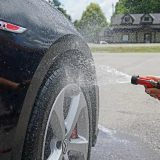Paint correction is the process of restoring and rejuvenating the paintwork of a car to remove imperfections such as swirl marks, scratches, and oxidation. It involves using various techniques and tools to carefully remove a thin layer of clear coat from the surface of the paint, revealing a fresh layer underneath. This process can greatly improve the appearance of a car and restore its original shine.Maintaining your car's paint is important for several reasons. Firstly, the paint is one of the first things people notice about a car, and a well-maintained paint job can greatly enhance its overall appearance. Secondly, the paint acts as a protective barrier against environmental factors such as UV rays, dirt, and pollutants. Over time, these factors can cause the paint to fade, chip, or peel, leading to costly repairs. Lastly, maintaining your car's paint can also increase its resale value. A car with a well-maintained paint job is more likely to attract potential buyers and command a higher price.The benefits of paint correction go beyond just aesthetics. By removing imperfections from the paint, you are also increasing its durability. This means that it will be more resistant to scratches and chips in the future. Additionally, by removing oxidation and other contaminants from the surface of the paint, you are protecting it from further damage. This can help prolong the life of your car's paint job and save you money in the long run.
Key Takeaways
- Paint correction is the process of removing imperfections from a car's paintwork to restore its original shine and finish.
- Understanding the science of paint correction involves knowing how to identify and address different types of paint defects, such as swirl marks, scratches, and oxidation.
- The benefits of paint correction go beyond aesthetics, as it can also improve the longevity and resale value of a car.
- Tools and techniques used in paint correction include polishing machines, compounds, and pads, which require skill and experience to use effectively.
- While DIY paint correction is possible, it may not achieve the same level of results as professional paint correction, which can be costly but worth the investment for those seeking a flawless finish.
Understanding the Science of Paint Correction: How it Works
The process of paint correction involves several steps and requires a good understanding of the science behind it. Firstly, the surface of the paint is carefully inspected to identify any imperfections such as swirl marks, scratches, or water spots. Once identified, these imperfections are then treated using various techniques and tools.Abrasives and polishes play a crucial role in the paint correction process. Abrasives are used to remove a thin layer of clear coat from the surface of the paint, effectively leveling out any imperfections. Polishes are then used to refine the surface and restore its shine. The type of abrasive and polish used will depend on the severity of the imperfections and the type of paint being corrected.Using the correct tools and techniques is also essential for achieving optimal results. Different types of polishers, such as rotary or dual-action polishers, can be used depending on the specific needs of the paint correction job. It is important to use the right combination of speed, pressure, and technique to ensure that the paint is corrected without causing any further damage.
The Benefits of Paint Correction: More than Just Aesthetics
While paint correction can greatly improve the appearance of a car, its benefits go beyond just aesthetics. One of the main benefits is improved resale value. A car with a well-maintained paint job is more likely to attract potential buyers and command a higher price. By investing in paint correction, you are essentially investing in the value of your car.Paint correction also provides protection against environmental factors. The paint acts as a protective barrier against UV rays, dirt, and pollutants. Over time, these factors can cause the paint to fade, chip, or peel, leading to costly repairs. By removing oxidation and other contaminants from the surface of the paint, you are protecting it from further damage and prolonging its life.Furthermore, paint correction increases the durability of the paint. By removing imperfections such as swirl marks and scratches, you are making the surface more resistant to future damage. This means that your car's paint job will be able to withstand everyday wear and tear better, saving you money on repairs in the long run.
Common Paint Defects: Identifying the Issues
| Paint Defect | Description | Cause | Solution |
|---|
| Orange Peel | Surface appears bumpy or textured like an orange peel | Improper spray gun technique, incorrect air pressure, or incorrect viscosity of paint | Adjust spray gun technique, air pressure, or viscosity of paint |
| Runs and Sags | Paint drips or sags down the surface | Applying too much paint or not allowing enough drying time between coats | Sand and repaint affected area |
| Fisheyes | Small circular craters in the paint surface | Contamination on the surface, such as oil or silicone | Clean and degrease the surface before painting |
| Peeling | Paint separates from the surface in flakes or strips | Moisture or poor adhesion to the surface | Remove loose paint, sand, and repaint affected area |
| Blistering | Bubbles or blisters form on the paint surface | Moisture or solvent trapped under the paint film | Remove affected area, sand, and repaint |
Before embarking on a paint correction project, it is important to identify the specific paint defects that need to be addressed. Some common paint defects include swirl marks, scratches, water spots, and oxidation.Swirl marks are fine scratches that are often caused by improper washing and drying techniques. They can give the paint a dull and hazy appearance, detracting from its overall shine. Scratches, on the other hand, can be caused by a variety of factors such as contact with sharp objects or improper washing techniques. They can range from minor surface scratches to deeper gouges in the paint.Water spots are another common paint defect that can be caused by hard water or improper drying techniques. They can leave behind mineral deposits on the surface of the paint, which can be difficult to remove. Lastly, oxidation occurs when the clear coat on the surface of the paint breaks down due to exposure to UV rays and other environmental factors. This can cause the paint to fade and lose its shine.
Tools and Techniques: The Process of Paint Correction
The process of paint correction involves several tools and techniques to achieve optimal results. Firstly, there are different types of polishers that can be used depending on the specific needs of the paint correction job. Rotary polishers are often used for more severe imperfections, while dual-action polishers are better suited for lighter correction work.Abrasives and polishes also play a crucial role in the paint correction process. Abrasives are used to remove a thin layer of clear coat from the surface of the paint, effectively leveling out any imperfections. The type of abrasive used will depend on the severity of the imperfections and the type of paint being corrected. Polishes are then used to refine the surface and restore its shine.Correcting paint defects requires a combination of speed, pressure, and technique. It is important to use the correct combination for each specific defect in order to achieve optimal results without causing any further damage to the paint. This requires a good understanding of the science behind paint correction and experience in using the correct tools and techniques.
DIY vs Professional Paint Correction: Which is Right for You?
When it comes to paint correction, you have the option of doing it yourself or hiring a professional. Both options have their pros and cons, and the choice ultimately depends on your level of skill, time, and budget.One of the main advantages of DIY paint correction is cost savings. By doing it yourself, you can avoid the expense of hiring a professional and potentially save hundreds of dollars. Additionally, DIY paint correction allows you to work at your own pace and on your own schedule. You have complete control over the process and can take as much time as you need to achieve the desired results.However, there are also some drawbacks to DIY paint correction. Firstly, it requires a certain level of skill and experience to achieve optimal results. If you are not familiar with the correct techniques and tools, you may end up causing further damage to the paint. Secondly, DIY paint correction can be time-consuming. It requires a significant amount of time and effort to properly correct paint defects, especially if they are severe.On the other hand, professional paint correction offers several benefits. Firstly, professionals have the knowledge, skills, and experience to achieve optimal results. They are familiar with the correct techniques and tools to use for each specific paint defect. Secondly, professional paint correction can save you time and effort. Instead of spending hours or even days working on your car's paint, you can leave it in the hands of a professional and focus on other tasks.However, professional paint correction does come at a cost. It is generally more expensive than DIY paint correction due to the expertise and equipment required. Additionally, you may need to schedule an appointment and wait for your car to be serviced, which can be inconvenient for some people.When choosing between DIY and professional paint correction, it is important to consider your level of skill, time, and budget. If you have the necessary skills and experience, as well as the time and patience to dedicate to the project, DIY paint correction may be a viable option. However, if you are unsure or do not have the time or expertise, it may be worth investing in professional paint correction to ensure optimal results.
Maintaining Your Car's New Look: Tips and Tricks
Once you have invested in paint correction, it is important to maintain your car's new look to ensure that it lasts as long as possible. Proper washing techniques are essential for maintaining the appearance of the paint. Avoid using harsh chemicals or abrasive materials that can damage the paint. Instead, use a pH-neutral car wash soap and a soft microfiber cloth or sponge to gently clean the surface.Regular maintenance is also important for preserving your car's new look. This includes regular waxing or sealing to provide an additional layer of protection against environmental factors. Waxing helps to fill in any microscopic imperfections in the paint and provides a barrier against UV rays, dirt, and pollutants. It also enhances the shine of the paint and makes it easier to clean.Protection against environmental factors is crucial for maintaining your car's new look. Park your car in a shaded area whenever possible to minimize exposure to UV rays. If you do not have access to covered parking, consider using a car cover to protect your car from the elements. Additionally, avoid parking under trees or near construction sites where your car may be exposed to sap, bird droppings, or other contaminants.
The Cost of Paint Correction: Is it Worth the Investment?
The cost of paint correction can vary depending on several factors such as the severity of the paint defects, the size of the vehicle, and the location of the service provider. Generally, professional paint correction can range from a few hundred dollars to over a thousand dollars.While the cost of paint correction may seem high, it is important to consider the value of the investment. A well-maintained paint job can greatly enhance the appearance of a car and increase its resale value. By investing in paint correction, you are essentially investing in the value of your car. A car with a well-maintained paint job is more likely to attract potential buyers and command a higher price.When comparing the cost of paint correction to other car maintenance expenses, it is important to consider the long-term benefits. While paint correction may seem expensive upfront, it can save you money in the long run by protecting your car's paint from further damage. By removing imperfections and providing an additional layer of protection, paint correction can help prolong the life of your car's paint job and save you money on costly repairs.
The Role of Paint Protection: Preserving Your Car's Beauty
In addition to paint correction, paint protection plays a crucial role in preserving your car's beauty. Paint protection refers to various products and techniques that are used to protect the paint from environmental factors such as UV rays, dirt, and pollutants.There are several types of paint protection available, including wax, sealants, and ceramic coatings. Wax is one of the most common forms of paint protection and provides a temporary barrier against environmental factors. It is easy to apply and provides a high gloss finish. However, wax needs to be reapplied regularly as it wears off over time.Sealants are another form of paint protection that provide a longer-lasting barrier against environmental factors. They are typically made from synthetic polymers or acrylics and can last up to six months or more. Sealants provide a high level of protection and are relatively easy to apply.Ceramic coatings are the most advanced form of paint protection available. They are made from nanotechnology and provide a permanent barrier against environmental factors. Ceramic coatings bond to the surface of the paint and create a protective layer that is resistant to UV rays, dirt, and pollutants. They provide a high level of gloss and make the paint easier to clean.Regardless of the type of paint protection you choose, it is important to maintain it properly. Regular washing and maintenance are essential for preserving the effectiveness of the paint protection. This includes using pH-neutral car wash soap, avoiding harsh chemicals or abrasive materials, and regularly applying additional layers of protection as needed.
Choosing the Right Professional: Finding the Best Paint Correction Specialist
When it comes to paint correction, choosing the right professional is crucial for achieving optimal results. There are several factors to consider when selecting a paint correction specialist.Firstly, it is important to consider their level of experience and expertise. Look for a specialist who has been in the industry for several years and has a proven track record of delivering high-quality results. Ask for before and after photos of their previous work to get an idea of their capabilities.Secondly, consider their reputation in the industry. Look for reviews and testimonials from previous customers to get an idea of their level of customer satisfaction. A reputable specialist will have positive reviews and a good reputation within the industry.Lastly, consider their pricing and availability. While cost should not be the sole determining factor, it is important to find a specialist who offers competitive pricing for their services. Additionally, consider their availability and turnaround time. If you need your car corrected within a specific timeframe, make sure that the specialist can accommodate your needs.In conclusion, paint correction is an important process for maintaining your car's paint and enhancing its overall appearance. By understanding the science behind paint correction and using the correct tools and techniques, you can achieve optimal results. Whether you choose to do it yourself or hire a professional, maintaining your car's new look through proper washing techniques, regular maintenance, and paint protection is essential. While there is a cost associated with paint correction, it is worth the investment for the improved resale value and protection it provides. By choosing the right professional, you can ensure that your paint correction project is a success.If you're looking for professional paint correction services, you'll want to check out this article on Fleet Details. They recently opened a car detailing shop serving Rockford, IL, in Cherry Valley, IL. With their expertise and attention to detail, they can transform your vehicle's appearance and restore its paint to its original glory. Whether you have a Dodge Durango R/T that needs some TLC or a white Hyundai sedan that could use a refresh, Fleet Details has got you covered. Don't let scratches or swirl marks ruin the look of your car - trust the experts at Fleet Details to provide top-notch paint correction services.
Read more



